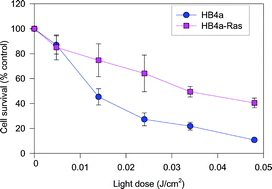Response to ALA-based PDT in an immortalised normal breast cell line and its counterpart transformed with the Ras oncogene†‡
Abstract

- This article is part of the themed collection: Photodynamic Therapy and Photodetection
* Corresponding authors
a
Centro de Investigaciones sobre Porfirinas y Porfirias (CIPYP), CONICET and Hospital de Clínicas José de San Martín, University of Buenos Aires, Viamonte 1881 10A, Argentina
E-mail:
batlle@mail.retina.ar
Fax: 54 11 4811 7447
Tel: 54 11 4812 3357
b National Medical Laser Centre, Royal Free and University College Medical School, University College London, London, UK

 Please wait while we load your content...
Something went wrong. Try again?
Please wait while we load your content...
Something went wrong. Try again?
L. Rodriguez, G. DiVenosa, A. Batlle, A. MacRobert and A. Casas, Photochem. Photobiol. Sci., 2007, 6, 1306 DOI: 10.1039/B704235C
To request permission to reproduce material from this article, please go to the Copyright Clearance Center request page.
If you are an author contributing to an RSC publication, you do not need to request permission provided correct acknowledgement is given.
If you are the author of this article, you do not need to request permission to reproduce figures and diagrams provided correct acknowledgement is given. If you want to reproduce the whole article in a third-party publication (excluding your thesis/dissertation for which permission is not required) please go to the Copyright Clearance Center request page.
Read more about how to correctly acknowledge RSC content.
 Fetching data from CrossRef.
Fetching data from CrossRef.
This may take some time to load.
Loading related content
